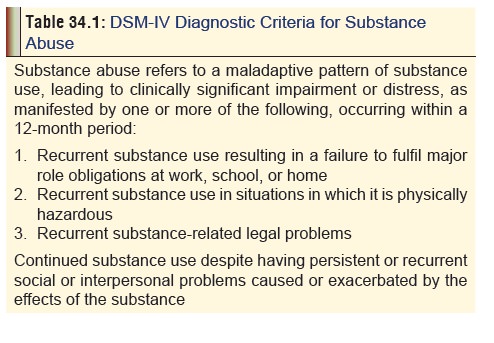Chapter: Modern Medical Toxicology: Substance Abuse: Substances of Dependence and Abuse
Substances of Dependence and Abuse
Substances of Dependence and Abuse
Use of psychoactive substances to
experience pleasurable effects is not a recent phenomenon, but has been
indulged in by human kind for hundreds, even thousands of years. Terminology in
the field of substance abuse has changed frequently leading to a great deal of
confusion. Therefore, it is necessary to begin this section by defining
currently used terms, and to clarify the differences between them. The
nomenclature and diagnostic schemes mentioned here -in are based on the 4th
edition of Diagnostic and Statistical Manual of Mental Disorders (DSM-IV), and
the 10th edition of International Classification of Diseases and Related Health
Problems (ICD-10).
DEFINITIONS
Substance Dependence
Substance
dependence arises out of a maladaptive pattern of substance use, leading to a
cluster of behavioural, cognitive, and physiological phenomena that develop
after repeated intake. It includes a strong desire to take the drug,
difficulties in control-ling its use, persisting in its use despite harmful
consequences, a higher priority given to drug use than to other activities and
obligations, increased tolerance, and sometimes a physical withdrawal state.
Polysubstance Dependence
This
term is reserved for behaviour during a 12-month period in which the person was
repeatedly using at least 3 groups of substances (not including caffeine and
nicotine), but no single substance predominated. Further, during this period,
the dependence criteria were met for substances as a group, but not for any
specific substance in isolation.
It
must be mentioned here that sometimes certain non-dependence producing
substances are abused by way of prolonged, unnecessary, or excessive intake,
which cannot be covered by the term “substance dependence”. For instance, drugs
such as analgesics, laxatives, antidepressants, antacids, vitamins, steroids,
or hormones, and specific herbal or folk remedies.
Substance Abuse
·
Substance abuse arises out of a maladaptive pattern of
substance use, manifested by recurrent and significant adverse consequences
related to the repeated intake of the substance. These problems must occur
recurrently during the same 12-month period. The criteria for substance abuse
do not include tolerance, withdrawal, or a pattern of compulsive use, and
instead include only the harmful consequences of repeated use.
The DSM-IV criteria for substance
abuse are listed in Table 34.1.

It is to be noted that the term “abuse”
when used by itself, merely refers to the use of an illicit drug, or the use of
a licit drug outside of legitimate medical practice.
Substance Intoxication
According
to DSM-IV, this term refers to unwanted physiolog-ical or psychological effects
that cause maladaptive behaviour. ICD-10 specifies that intoxication must
produce disturbances in the level of consciousness, cognition, perception,
affect, or behaviour that are clinically significant.
Substance Induced Disorders
Use
of certain psychoactive substances can induce syndromes (formerly called
“organic mental disorders”) which include the following: substance intoxication
(vide supra), substance withdrawal,
intoxication delirium, withdrawal delirium, dementia, amnestic disorders,
psychotic disorders, mood disorders, anxiety disorders, sexual dysfunctions,
and sleep disorders.
Substance Withdrawal
As
per DSM-IV, “substance withdrawal” should be restricted to major symptoms
resulting from the cessation of substance abuse, accompanied by a maladaptive
behaviour change. There should be clinically significant distress or impairment
in social, occupational, or other important areas of functioning. DSM-IV does
not recognise withdrawal from caffeine, cannabis, or phencyclidine. ICD-10
recognises cannabinoid withdrawal state, as well as a withdrawal state from
other stimulants, including caffeine.
Physical Dependence
The
term “physical” or “physiological” dependence is defined as an alteration in
neural systems which is manifested by tolerance and the appearance of
withdrawal phenomena when a chronically administered drug is discontinued or
displaced from its receptor.
The
1980 ADAMHA-WHO* working group recommended substituting the term
“neuroadaptation” for physical depend-ence.
Addiction
The
term “addiction” denotes a chronic disorder characterised by compulsive use of
drugs (craving ) resulting in
physical, psychological, and social harm, and continued use despite evidence of
that harm (denial).
Related Topics